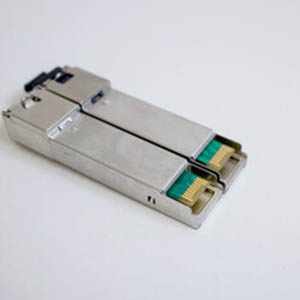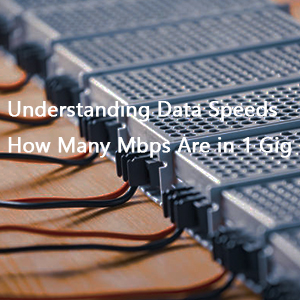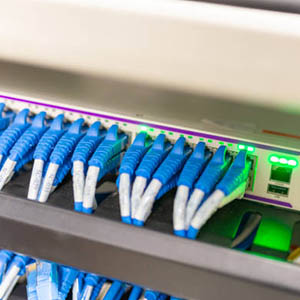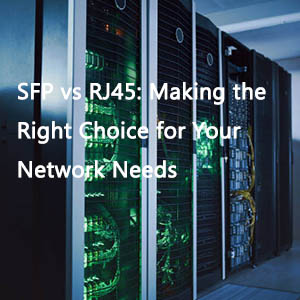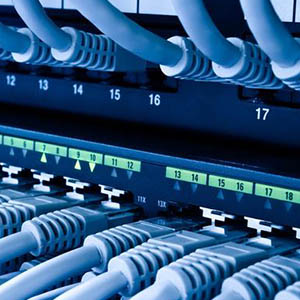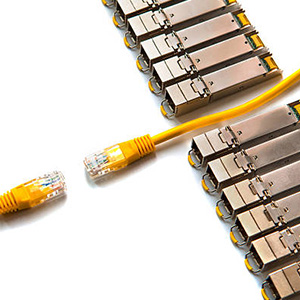With the deployment of 40G Ethernet in most data centers, a variety of network devices designed for 40GbE links have appeared on the market. 40G transceivers are undoubtedly an indispensable component. Generally speaking, 40G QSFP+ transceivers use two interfaces – MTP/MPO and LC. So, what is the difference between 40G QSFP+ MTP and 40G QSFP+ LC transceivers?
40G QSFP+ MTP module
It is a QSFP+ transceiver equipped with an MTP interface, which is usually used with MTP/MPO fiber patch cords. MTP is an enhanced version of the universal MPO (multi-fiber push-in), and the two can be used interchangeably. In most cases, we usually just use “MTP” for convenience. 40GbE QSFP+ MTP modules are usually connected with 8 or 12-fiber MTP patch cords, which end with 12-fiber parallel (female) MTP connectors.

40G QSFP+ LC Module
It is a QSFP+ transmitter equipped with LC interface, usually used with LC fiber patch cords. 40GbE QSFP+ LC module is usually connected with 2 fiber duplex LC patch cords, which are terminated with 2 fiber duplex LC connectors.
40G QSFP+ LC transceiver—On the transmit side, 4-channel 10G serial data streams are passed to laser drivers.

40G QSFP+ MTP vs LC Transmitter
Its main difference lies in the working principle. At the transmitting end, the 40G QSFP+ MTP transmitter converts parallel electrical signals into parallel optical signals through a laser array, and then transmits them simultaneously through MTP parallel cables. At the receiving end, the receiver converts parallel optical signals into parallel electrical signals through a photodiode array. It is worth mentioning that the 40G QSFP+ transmitter with MTP interface can achieve 4x10G connection through an external 12 fiber parallel to 2 fiber duplex splitter cable.
40G QSFP+ LC Transmitter
At the transmitting end, 4 channels of 10G serial data streams are transmitted to the laser driver. The laser driver controls the directly modulated laser (DML) at a wavelength. Then, the outputs of the four DMLs are optically multiplexed in the fiber optic cable through the LC connector and combined into a 40G optical signal. At the receiving end, the 40G optical signal is demultiplexed into 4 independent 10G channels, and the light of each wavelength is collected by the PIN, and then amplified by the TIA (transimpedance amplifier) and output as electrical data. Unlike the 40G QSFP+ transmitter with MTP interface, the 40G QSFP+ transmitter with LC interface cannot be split into 4x10G because they use 4 wavelengths on a pair of single-mode optical fibers.
Single-mode fiber (SMF)
It has stricter tolerance requirements for the optical components used. Its core is smaller and the laser wavelength is narrower, which means that SMF has higher bandwidth and longer transmission distance capabilities. Generally, 40G QSFP+ transmitters equipped with LC interface are used for long-distance data transmission through SMF, except that 40GBASE-BiDi uses LC interface for short-distance transmission on multimode fiber (MMF) (OM3 100 meters; OM4 150 meters).
Multimode fiber
It uses a larger core and generally uses a longer wavelength of light. Therefore, the optical components used in MMF have a higher ability to collect light from the laser. 40G QSFP+ transmitters equipped with MTP interfaces are generally used for short-distance transmission through MMF, except for 40GBASE-PLR4 and 40GBASE-PLRL4, which support long-distance transmission through SMF.
40G QSFP+ MTP vs. LC transmitters: What are their matching jumpers?
In the 40G transmission network, advanced switches, matching jumpers, and transmitter modules are all indispensable. Learning to choose the right jumper for 40G transmitters is still of great significance. Generally speaking, the choice of jumper is affected by two main factors: transmission distance and connector type.
See the table below for detailed information of nine common QSFP+ modules’ patch cords selection:
| Model | Application | Cable Type & Polish Type | Polarity (typically) |
|---|---|---|---|
| 40GBASE-SR4 40GBASE-CSR4 | 40G-40G | MTP-12 UPC MMF Female Trunk | Type B |
| 40G-4x10G | MTP-8 UPC to 8xLC MMF APC Female Harness | Type B | |
| 40GBASE-PLRL4 40GBASE-PLR4 | 40G-40G | MTP-12 APC SMF Female Trunk | Type B |
| 40G-4x10G | MTP-8 APC to 8xLC UPC SMF Female Harness | Type B | |
| 40GBASE-LR4 40GBASE-LR4L 40GBASE-ER4 | 40G-40G | LC UPC Duplex SMF Fiber Optic Patch Cable | N/A |
| 40GBASE-BiDi | 40G-40G | LC UPC Duplex MMF Fiber Optic Patch Cable | N/A |
| 40GBASE-LR4 40GBASE-LR4L 40GBASE-ER4 | 40G-40G | LC UPC Duplex SMF/MMF Fiber Optic Patch Cable | N/A |
The above six transmitters are suitable for short or long 40G transmission, such as 40GBASE-SR4 (short distance) and 40GBASE-LR4 (long distance). For 40G QSFP+ short transmission distance, MMF is recommended, while for 40G QSFP+, SMF is recommended.
For 40G QSFP+ MTP transceivers, the MTP cable can be an MTP trunk cable or an MTP bundle cable. An MTP trunk cable is a cable with MTP connectors on both ends, which serves as a permanent link to connect to an MTP interface module. An MTP trunk cable is used with a 40G QSFP+ transceiver module for 40G-40G connections. An MTP bundle cable, also known as a fan-out cable or splitter cable, has an MTP connector on one end and four LC duplex connectors on the other end. An 8-fiber MTP to LC duplex splitter cable with a 40G QSFP+ transceiver and four 10G SFP+ transceivers can achieve a 40G-4x10G connection.
Unlike the previous 40G QSFP+ MTP module, the 40G QSFP+ LC transceiver is only suitable for 40G-40G connections. The matching of the transmitter and the patch cord is as follows: 40GBASE-BiDi transmitter can use OM3 or OM4 multimode LC duplex patch cord to transmit full-duplex 40Gbps traffic, 40GBASE-LR4/LR4L/ER4 is usually used with single-mode LC duplex patch cord, and 40GBASE-UNIV with LC interface supports SMF and MMF LC patch cords.
FAQ
There are MTP and MPO cables on the market, what is the difference between them, how to choose 40G QSFP+ MTP?
MPO stands for “Multi-Fiber Push-On”. While MTP is the trademark name of MPO connector manufactured by US Conec, it is not fully compatible with MPO connector. Please note that all MTPs are MPOs, but not all MPOs are MTPs. Both MTP and MPO connectors are viable solutions, but MTP is an enhanced version of MPO with a small price difference. Generally, MTP patch cords are recommended.
40GBASE-UNIV QSFP+ transmitter can work at 850nm wavelength, can OM1 patch cords be used?
The answer is yes, but it is not recommended. Using OM1 with 40G QSFP+ transceivers, the transmission distance and quality will be limited. OM1 patch cords are generally recommended for 100Mbps and 1000Mbps transmission. In this case, two optimized multimode fiber cables are more suitable for short distances – OM3 and OM4.

